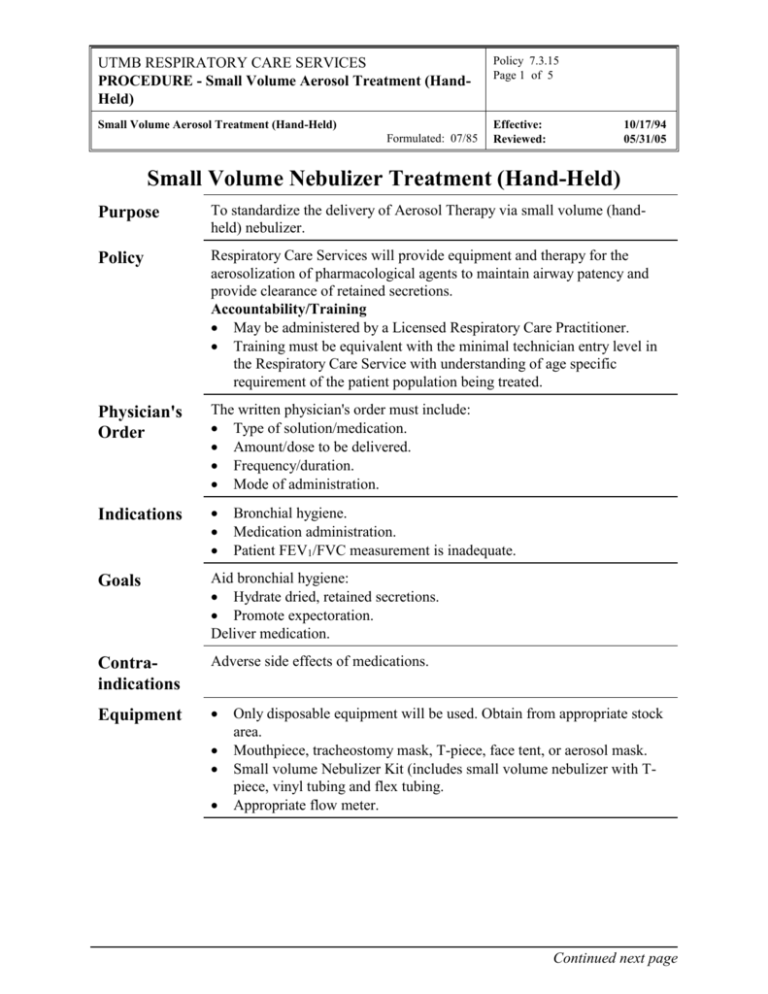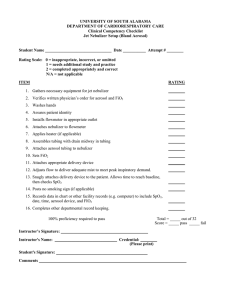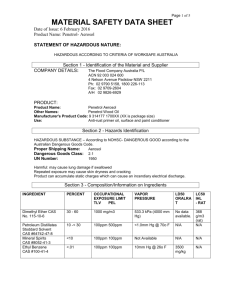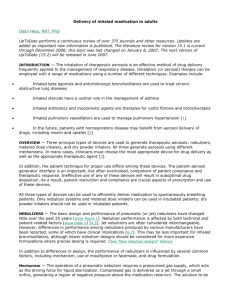Small Volume Aerosol Treatment (Hand
advertisement

UTMB RESPIRATORY CARE SERVICES PROCEDURE - Small Volume Aerosol Treatment (HandHeld) Policy 7.3.15 Page 1 of 5 Small Volume Aerosol Treatment (Hand-Held) Effective: Reviewed: Formulated: 07/85 10/17/94 05/31/05 Small Volume Nebulizer Treatment (Hand-Held) Purpose To standardize the delivery of Aerosol Therapy via small volume (handheld) nebulizer. Policy Respiratory Care Services will provide equipment and therapy for the aerosolization of pharmacological agents to maintain airway patency and provide clearance of retained secretions. Accountability/Training May be administered by a Licensed Respiratory Care Practitioner. Training must be equivalent with the minimal technician entry level in the Respiratory Care Service with understanding of age specific requirement of the patient population being treated. Physician's Order The written physician's order must include: Type of solution/medication. Amount/dose to be delivered. Frequency/duration. Mode of administration. Indications Goals Aid bronchial hygiene: Hydrate dried, retained secretions. Promote expectoration. Deliver medication. Contraindications Adverse side effects of medications. Equipment Bronchial hygiene. Medication administration. Patient FEV1/FVC measurement is inadequate. Only disposable equipment will be used. Obtain from appropriate stock area. Mouthpiece, tracheostomy mask, T-piece, face tent, or aerosol mask. Small volume Nebulizer Kit (includes small volume nebulizer with Tpiece, vinyl tubing and flex tubing. Appropriate flow meter. Continued next page UTMB RESPIRATORY CARE SERVICES PROCEDURE - Small Volume Aerosol Treatment (HandHeld) Policy 7.3.15 Page 2 of 5 Small Volume Aerosol Treatment (Hand-Held) Effective: Reviewed: Formulated: 07/85 10/17/94 05/31/05 Procedure Step Action 1 Check physician's order sheet. Verify patient ID 2 Wash hands. 3 Explain purpose of therapy and procedure to the patient. 4 Plug flow meter into 50psi wall outlet (or use portable compressor). 5 Attach T-piece to top of nebulizer. 6 Attach one end of the vinyl tubing to the nipple adapter of the flow meter. Attach other end of tubing to nipple adapter on the bottom of nebulizer. 7 Add proper mediation to small volume nebulizer. 8 Attach mouthpiece to one end of nebulizer T-piece and the flex tubing to the other end of the T-piece. 9 If using alternate appliance (i.e., Trach mask, aerosol mask) connect appliance to top of nebulizer. 10 Position patient in semi-Fowler's sitting position as tolerated. 11 Monitor patient's respiratory rate and pulse prior to beginning treatment and auscultate the patient's chest. 12 Turn on flow meter to 5-7 lpm. 13 Begin treatment. • If using a mouthpiece, have patient place mouthpiece on top of tongue, holding it gently between the teeth with lips sealed around it. If patient is alert but unable to make a seal, use lip seal and/or nose clips. • If an aerosol mask is necessary, gently extend patient's head and bring mask down over nose, then lower over mouth. • If patient is intubated or trached, attach adapter to tube or use trach collar. 14 When administering therapy to a patient on mechanical ventilation attach the small volume nebulizer in-line with Continued next page UTMB RESPIRATORY CARE SERVICES PROCEDURE - Small Volume Aerosol Treatment (HandHeld) Policy 7.3.15 Page 3 of 5 Small Volume Aerosol Treatment (Hand-Held) Effective: Reviewed: Formulated: 07/85 10/17/94 05/31/05 Procedure Continued Step Action 14 Continued With the inspiratory side of the circuit, proximal to the patient wye. Power the nebulizer via vinyl tubing connected to the oxygen flow meter. Remove set-up form circuit when treatment is completed. 15 Instruct patient to take slow deep breaths during course of treatment with a 3-5 second inspiratory hold, if tolerated. 16 Monitor patient's RR and pulse during and after treatment and notify physician of any significant changes. 17 Encourage any spontaneous cough during treatment and ask patient for voluntary cough following treatment. Note patient's effort and sputum production. 18 Auscultate the patient chest. 19 Discard remaining contents of solution in nebulizer. 20 Place equipment in patient plastic equipment bag. 21 Chart RCS treatment card and RCS patient flow sheet on chart per RCS Policies # 7.1.1 and # 7.1.2. Discontinuation of Orders The patient will be evaluated after every treatment. A complete pulmonary assessment will be done every 72 hours or as indicated. Based on the assessment the therapist will write a SOAP note and make recommendations for changes in therapy or discontinuance as needed. Undesirable Side Effects Airway obstruction resulting from the swelling of dried, retained secretions that result in partially plugged airways. Bronchospasm from the aerosol droplets and certain medications. Adverse side effects of medications. Drug re-concentration. Continued next page UTMB RESPIRATORY CARE SERVICES PROCEDURE - Small Volume Aerosol Treatment (HandHeld) Policy 7.3.15 Page 4 of 5 Small Volume Aerosol Treatment (Hand-Held) Effective: Reviewed: Formulated: 07/85 Assessment of Outcome 10/17/94 05/31/05 The effectiveness of small volume aerosol treatment will be judged on how well it accomplishes the stated clinical goals. Observation of the following should be noted on the RCS flow sheet and in the patient progress notes. Includes, but is not limited to: Sputum - color, amount, consistency. Auscultation - comparison of pre- and post-treatment breath sounds; breath sounds improved. Arterial blood gas measurement and/or pulse oximetry. Work of breathing - evaluating the ventilatory pattern, use of accessory muscles; decreased WOB. Color – presence of cyanosis. Patient's subjective response ("breathing easier"). FEV1/FVC and/or peak flow improvement. (If ordered, measured before and after treatment) Patient Teaching Step Action 1 Explain to the patient why he/she is receiving small volume aerosol treatment. Relate it to the disease or injury state. 2 Instruct proper body alignment for maximal breathing efficiency. 3 Proper cough instruction or cough assistance. 4 Instruct patient to breathe through the mouth or trach and to breathe slowly and deeply - a slight inspiratory pause is ideal. 5 Instruct patient to breathe diaphragmatically to assure that the maximum distribution and deposition of aerosol will occur in the basilar areas of the lung. 6 Alert patient to possible onset of strong cough. 7 As a result of the educational aspects of this therapy, the patient should be able to verbalize and demonstrate understanding of this therapy. Continued next page UTMB RESPIRATORY CARE SERVICES PROCEDURE - Small Volume Aerosol Treatment (HandHeld) Policy 7.3.15 Page 5 of 5 Small Volume Aerosol Treatment (Hand-Held) Effective: Reviewed: Formulated: 07/85 10/17/94 05/31/05 Infection Control Follow procedures outlined in Healthcare Epidemiology Policies and Procedures #2.24; Respiratory Care Services http://www.utmb.edu/policy/hcepidem/search/02-24.pdf. Safety References AARC Clinical Practice Guidelines: Delivery of Aerosols to the Upper Airway, Respiratory Care, 1995 39(8): 803-807. Instruct patient and visitors in safety rules for oxygen. Safety guidelines as outlined in section 3.6 of this manual will be followed. AARC Clinical Practice Guidelines: Selection of a device for delivery of aerosol to the lung parenchyma. Respiratory Care, 1996; 41:647-653. AARC Clinical Practice Guidelines: Selection of aerosol delivery device. Respiratory Care, 1992; 37:891-897. AARC Clinical Practice Guidelines:. Selection of an aerosol delivery device for neonatal and pediatric patients. Respiratory Care, 1995; 40:1325-1335. AARC Clinical Practice Guidelines: Assessing Response to Bronchodilator Therapy at Point of Care, Respiratory Care, 1995; 40(12): 1300-1307. Dean Hess (Editor), et al Respiratory Care -- Principles and Practice W B Saunders; 1st edition (October 2001) Kendrick AH, Smith EC, Wilson RS. Selecting and using nebuliser equipment. Thorax. 1997; 52 Suppl 2:S92-101. Hess D; Aerosol therapy, In: Dantzker DR, MacIntyre NR, Bakow ED, Eds. Comprehensive Respiratory Care. Philadelphia: WB Saunders; 1995. Op't Holt TB; Aerosol generators and humidifiers. In: Barnes TA, Ed. Core Textbook of Respiratory Care Practice. 2 edition, St. Louis: Mosby-Year Book; 1994.











